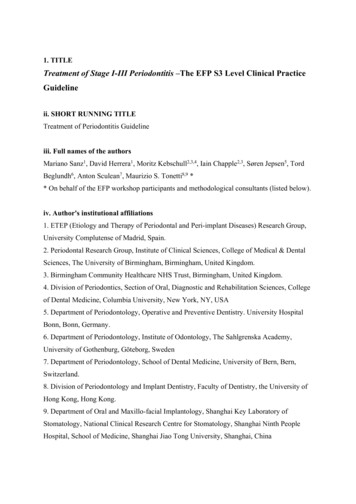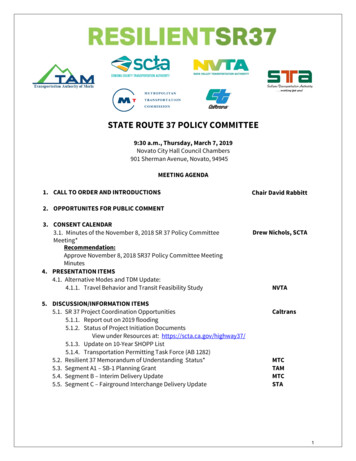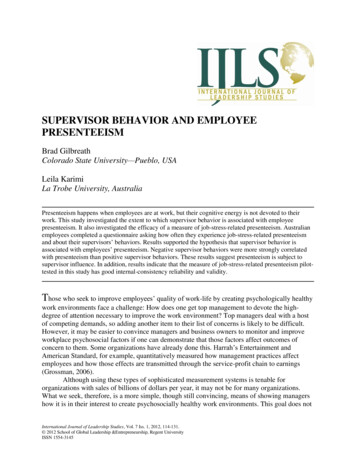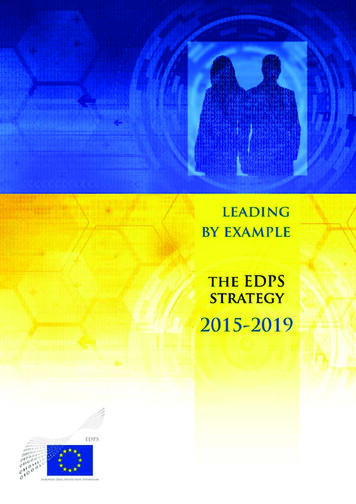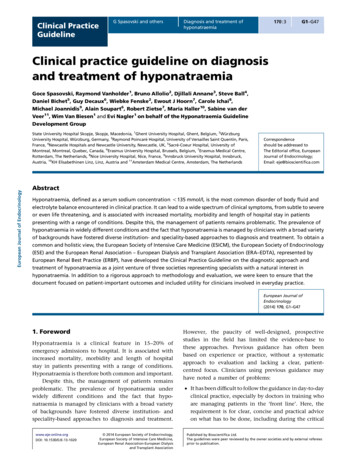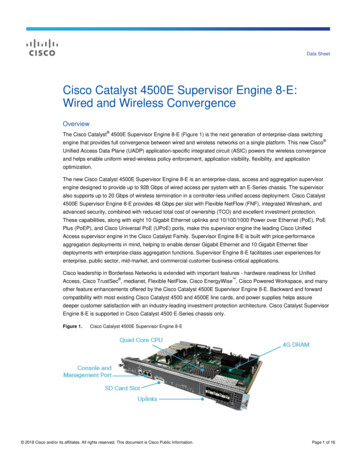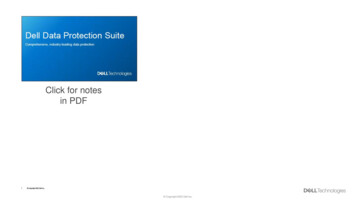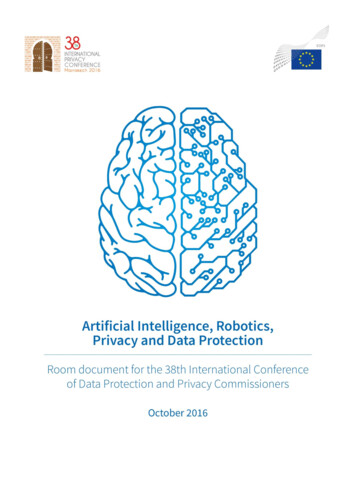
Transcription
1. Executive summaryArtificial intelligence and robotics are increasingly a reality and also present in the political agenda.Due to the interest of the topic, it is being discussed in the ICDPPC 2016.Some people may claim it is too early to start discussing artificial intelligence and robotics but we cansee the applications of artificial intelligence and robotics already and the data protection authoritiesneed to start discussing them and developing a position.We need to adopt a realistic approach, neither luddite1 nor evangelical. A proper consideration willnot slow down innovation but provide sound foundations for these technological developments.By default the data protection framework is mainly applicable to controllers, few provisions apply tothe whole artificial intelligence/robotics ecosystem: Data protection by design and by default can onlybe a reality if all the actors involved apply data protection principles.This is a background document to stimulate and contribute to the discussion within the closed sessionof the ICDPPC 2016.2. TopicsThe following sections explore some popular artificial intelligence and robotics topics which arerelevant for a discussion about the impact of artificial intelligence and robotics on data protection andprivacy. Each topic is introduced briefly and some questions for reflection and discussion arepresented.2
(This page intentionally left blank.)3
2.1.Big data, profiling and automatic decision making‘Big data’2 refers to the practice of combining huge volumes of diversely sourced information andanalysing them, often using artificial intelligence – machine learning solutions, to provide insight. Oneof the greatest values of big data is derived from the monitoring of human behaviour, collectively andindividually, and its predictive potential3.The relation between artificial intelligence and big data is bi-directional: Artificial intelligence, throughmachine learning, needs a vast amount of data to learn: data in the realm of big data considerations.On the other direction, big data uses artificial intelligence techniques to extract value from bigdatasets.One of the main issues regarding big data is information to individuals: transparency. Unlessindividuals are provided with appropriate information and control, they ‘will be subject to decisionsthat they do not understand and have no control over’4. Having that appropriate information can becomplicated by two different factors: organisations claiming secrecy over how data is processed ongrounds of trade secrets and the intrinsic difficulty in providing an explanation for a prediction whenthat prediction is based on an artificial intelligence algorithm that has been created using machinedlearning: the logic behind the machine reasoning may not be expressible in human terms.Another very important concern with regards to artificial intelligence and big data is the bias inducedvia the input dataset provided for training the artificial intelligence. As the machine learns from theinformation provided and has no means to contrast that information with a bigger picture, whateverbias is contained in the training set will influence the predictions made. If those predictions are usedto take decisions, a vicious circle of self-fulfilling prophecies can be created where the feedback themachine receives reinforces the bias present in the first place.When machine learning is used to process big data, for DPAs to be able to look into the black box5 ofthe algorithm is not useful. The analysis needs to be done on the machine learning process itself andon the data feed (to detect a possible bias). Indeed, we may come to the situation where for analysinga particular algorithm or artificial intelligence, a DPA may need to create another one, or use someanalytics tool, to confirm that the model created in the first place is fair. This could lead to creating aself-referencing problem difficult to solve.4
Elements for reflection- How can DPAs support the right to information from the data subjectwhen confronted with big data, artificial intelligence and machinelearning?- How to evaluate the bias in automated decisions when artificialintelligence and machine learning is used?- How can DPAs supervise appropriately an organisation using intensivelybig data, artificial intelligence and machine learning?- Should DPAs create their own pool of artificial intelligence experts andresources to be able to re-create and analyse the models used by theorganisations under supervision?References------FTC Big Data: A Tool for Inclusion or Exclusion? Understanding the Issues (6 January 2016) n-or-exclusion-understanding-issues-ftcreportEDPS Meeting the challenges of big data, A call for transparency, user control, data 5/15-11-19 Big Data EN.pdfEDPS Towards a new digital ethics: Data, Dignity and Technology (11 September 2015) /15-09-11 Data Ethics EN.pdfWP29 Statement of the WP29 on the impact of the development of big data on the protectionof individuals with regard to the processing of their personal data in the EU (16 September2014) - 4/wp221 en.pdfNorwegian Data Protection Authority The Chilling Effect in Norway (January 2014), http://www.datatilsynet.no/Global/04 planer rapporter/Nedkj%C3%B8ling%20i%20norgeeng .pdfOffice of the Australian Information Commissioner (OAIC) Consultation draft: Guide to ata-and-the-australianprivacy-principles.pdf5
2.2.Image recognitionDetermining which objects are present in an image, whether a static one (photo) or in a sequencevideo, is a classical problem in computer vision. This capability can be further developed as being ableto recognise a particular object through several images or in video, detection of certain objects orcircumstances, etc. Some actual practical applications are photo tagging, counting people in publicspaces or, a very interesting one, facial recognition.Currently, the best algorithms for image recognition are based on convolutional neural networkswhich in turn are a specific implementation of machine learning. The performance of these algorithmsis now close to that of humans. As these algorithms are based on machine learning, they depend onthe amount of training data (pictures tagged) that they can use. Fortunately for them, tagged pictureson the Internet are quite abundant.Using facial recognition is possible to identify a person from a digital image or a video. This is achievedby detecting a face in the image or video and comparing it with a database containing both facepictures and metadata associating the picture with a person. Our face, like our fingerprints, is abiometric identifier: our facial characteristics and the proportions of our head do not change. As forfingerprints, specific characteristics are extracted (minutiae), for face recognition, the same process isapplied (i.e. measuring nodal points on the face, such as the distance between the eyes or the shapeof the cheekbones).Currently there is an ongoing debate on the privacy implications and surveillance possibilities. Withthe widespread use of CCTV, the amount of video sources for identifying people is increasingconstantly. For example, some airports are considering installing one of these systems to improvetheir security, although previous experiences have not produced the expected good results. Recently,the focus has shifted to its use in border control.6
Elements for reflection- What should be the policy on using publicly available information fortraining image recognition algorithms based on machine learning?- The combination of face recognition with camera-equipped drones andeasily accessible tagged photos makes a very powerful surveillancesystem available for everyone; are we reaching the limits of the householdexception?- How to supervise face recognition used for security or intelligencepurposes?References------WP29 Opinion on developments in biometric technologies (27 April 2012) 2/wp193 en.pdfWP29 Opinion on facial recognition in online and mobile services (22 March 2012) 2/wp192 en.pdfEPIC Facial recognition - https://epic.org/privacy/facerecognition/CDT Seeing Is IDʼing: Facial Recognition & Privacy (22 January 2012) https://cdt.org/files/pdfs/Facial Recognition and PrivacyCenter for Democracy and Technology-January 2012.pdfDutch DPALetter to Google regarding Google Glass (18 June 2013) lt/files/downloads/int/med 20130618 letter-to-google-regarding-glass.pdfOffice of the Privacy Commissioner of Canada Automated Facial Recognition in the Public andPrivate Sectors (13March2014) - research/explore-privacy-research/2013/fr 201303/Privacy Commissioner for Personal Data (Hong Kong) Collection and Use of Biometric Data (13April2016)https://www.pcpd.org.hk/english/news events/speech/files/HKGCC Luncheon 20160413.pdf7
2.3.Natural language processingNatural language processing is a research area aiming to provide computers with the capacity tointeract with persons using natural languages. Natural language processing involves natural languageunderstanding and generation.The first natural language processing systems were based on complex sets of rules designed byresearchers. Since the late 1980s the approach changed with the introduction of machine learningalgorithms. Current solutions implement a type of machine learning which needs vast amounts of datawhich is not a problem thanks to the Internet.There are many products on the market using natural language processing. Some of the most popularare smartphone assistants like Google Now, Apple Siri or Microsoft Cortana24, or automatedtranslation services like Google Translate or Bing Translator6.Natural language processing systems may have the following capabilities (the list is far fromexhaustive): Machine translation: Automatically translate text from one human language to another. Thisis quite a complex problem requiring all possible capabilities from a natural languageprocessing system.Natural language understanding: Converting (written) natural language into a formalrepresentation easier to manipulate by a computer.Question answering: Being able to answer a question formulated in natural language.Questions can be specific or open-ended.Information extraction: The extraction of semantic information from a text.Sentiment analysis: Extract subjective information usually from a discourse, written or oral(through speech recognition). This is a quite controversial area of research with a big impacton marketing or political science.Speech recognition: Extract the textual representation of an oral speech. This is also a verydifficult problem due to the particularities of oral language.IBM Watson24 is a very good example of a system combining several of the capabilities mentionedabove: natural language understanding, question answering and information extraction.Besides those impacts on personal data and privacy common to all machine learning technologies,natural language processing also opens a possibility for data protection authorities to use these newtechnologies when performing their supervision responsibilities.8
Elements for reflection- Natural language processing opens the possibility of processingunstructured data, will we see an erosion on purpose limitation forpersonal data stored in (old) documents?- Natural language processing uses like question answering and customerlike interactions, will they foster automated decisions?- How will natural language processing alter the balance betweenmetadata and actual data?- Could DPAs use this technology? Some examples: Interactions with datasubjects, pre-analysis of mandatory reporting by controllers (DPIAs, databreach notifications), law and jurisprudence analysis and query.References-D. Hovy , S.L. Spruit, The Social Impact of Natural Language /download/ethics.pdfN. Kasch, Text Analytics and Natural Language Processing in the Era of Big Data (24 -processing-in-the-era-of-big-data9
2.4.Autonomous machinesAn autonomous machine (or autonomous robot) is one that is able to operate with a high degree ofautonomy. This makes these machines particularly desirable, e.g. in dangerous or inhumanenvironments or for performing taxing tasks. For a machine to be autonomous it needs to: (1) perceiveand react to its environment; (2) plan and realise pre-planned tasks; (3) operate without humanintervention (including supplies and maintenance) and (4) be able to navigate a, sometimes human,environment. An autonomous machine may also learn from its own experience or throughreprogramming.One of the most important requirements for autonomous machines is to avoid hurting people orobjects in their operational environment (unless on purpose.)Probably the most widespread example is the home cleaning robot Roomba by iRobot although someother uses are being tested like home delivery or the upgrade of the factory robot (Baxter7).All features of artificial intelligence may be applied in autonomous machines: natural languageprocessing allows the direct interaction between humans and machines, image recognition is apowerful tool which allows robots to understand their environment and all this is supported bymachine learning.Autonomous machines can be considered artificial intelligences with physical bodies able to interactphysically with their surrounding world. As such, from an impact or consequences point of view, theyrepresent the apex of the artificial intelligence discussion. An extreme example could be anautonomous weapons system8 capable of operating autonomously even up to the point of selectingtargets: the combination of that capability with face recognition could create the ultimate assassin.10
Elements for reflection- When implemented in autonomous machines automated decisions canhave an even greater impact. How could the data protection/privacyframework for automated decisions be applied to autonomous machines?- Who is the data controller for an autonomous machine with self-learningcapabilities?- Should the data protection/privacy community translate the legalframework into machine readable law?References---U. Pagallo, Robots in the cloud with privacy: A new threat to data protection? (October 23308 Robots in the cloud with privacyA new threat to data protectionU. Pagallo, What Robots Want: Autonomous Machines, Codes and New Frontiers of LegalResponsibility (12 March 2013) 7-63142 3L. Edwards and A. Winfield, Regulating Robots (15 November /law/cilp/strath robot launch.pdf11
2.5.Self-driving carsSelf-driving cars are probably the most popular example of an autonomous machine. Also, it is one ofthe best cases to reflect on the ethical dimensions of artificial intelligence and robotics. Self-drivingvehicles will change the way individual travel is used and organised, and may blur the differencebetween private and public transport. The artificial intelligences steering the cars will govern decisionswhich may directly concern the physical integrity and even the life or death of individuals.More formally, a self-driving car (also called driverless car or autonomous car) is a vehicle that iscapable of navigating its environment according to a predefined objective without human input.There are many potential advantages like:-Reduction in collisions caused by human error.Improved capability to manage traffic flow and the possibility to eliminate certain externalitiesto human vehicle driving like traffic police or road signals.Changes in vehicles interior as no driving interface would be needed anymore.No more time consuming driving for both professional and personal reasons. (As aconsequence professional driver jobs will be lost.)Higher speed limits and roadway capacity.New business models: car fleets self-operated; extinction of the privately-owned car;automatically shared private cars when not in use, etc.For the possibilities to materialise several obstacles need to be overcome. Among them:-The absence of a specific legal framework, also regarding liability and insurance. The new legalframework will need to take into account new ownership models.Substitution of the old human-driven fleet of vehicles to fully benefit from the technology.Individuals not wanting to relinquish their cars or driving them.As artificial intelligences existing on a substrate of computing power, these machines will beopen to attack and intromission.The road infrastructure will need to be adapted to the specific requirements of self-drivingcars to fully exploit their advantages.From a privacy or data protection point of view, as we see continuously through this document, thebiggest implication is the use of data, most of the time personal data. Self-driving cars need as perfectas possible cartography to operate but also as much information as possible on other vehicles andtheir trips (e.g. for congestion management.) If we consider this need for information together withnew business models and the sensitivity of geolocation information in certain cases we are providingcertain economic actors with an incredible profile of our daily whereabouts.12
Elements for reflection- All questions applicable to autonomous machines apply to self-driving carsas well.- How to regulate self-learning machines (self-driving cars) processing hugeamounts of geolocation data?- What will be the impact of new business and ownership models on datasubject/data controller/data processor relations?- There are plenty of ethical considerations on self-driving cars (as the mostcurrent and popular example of autonomous machines), how are selfdriving cars going to impact fundamental rights close to privacy and dataprotection like freedom of expression or freedom of association?References----US Department of Transportation Federal Automated Vehicles Policy ( 21 September 2016) /docs/AV%20policy%20guidance%20PDF.pdfShearman & Sterling, Connected Cars and Self-Driving Cars: Not on Auto Pilot in Terms of LegalRisks(11July2016)http://www.shearman.com/ in-Terms-of-Legal-Risks-PDP-071116.pdfFreshfield Bruckhaus Deringer, From Connected to Self-Driving Vehicles: the com/en/global/auto/regulatory roadmap/?LangType 2057B. Camarda, New guidelines: cybersecurity, privacy and your self-driving car (21 September2016) g-car/13
2.6.(Semi-)autonomous/unmanned aircraft systemsPopularly called drones, although more appropriately called unmanned aircraft systems (UAS) orremotely-piloted aircraft system (RPAS)9 depending on their autonomy, these are aircraft systems thatcan fly without requiring an on-board pilot. Currently drones serve mainly military purposes, but areincreasingly used for purposes of surveillance, mapping, transportation, logistics and public securitythanks to the sensors they carry such as cameras, microphones, GPS, which may allow the processingof personal data.Whether manned or unmanned, drones can be used for several tasks: By companies, public authorities and professionals to monitor large-scale infrastructures suchas bridges, energy plants (including nuclear ones), railways; apply pesticides on agriculturalland; inspect electricity networks; carry out aerial mapping; monitor a concert zone; secure anarea; deliver pizzas or books ordered; take wedding pictures or report on an event.Law enforcement uses, such as search and rescue; disaster response; bordercontrol/protection; civil protection; aerial surveillance; traffic monitoring; observation andpursuit of criminal suspects or observation of civil unrest.Military ones able to carry out missions such as surveillance, reconnaissance and airstrikes.Private uses by citizens as a hobby, such as model aircraft activities, photography, informationtechnology.Drones should be distinguished from aeroplanes and CCTV because their mobility and discretionenable them to be used in many more circumstances. Besides, when combined with the differentsensors mentioned previously they become potentially powerful surveillance tools.The intersection between drones and artificial intelligence may occur at several levels: drones maycollect the information to be processed by an artificial intelligence algorithm remotely, drones alreadyimplemented intelligent reflexes to make themselves easier to control for their human pilots; ordrones can equip an autonomous artificial intelligence themselves rendering human intervention,besides providing general instructions,10 unnecessary (an example of an autonomous machine).14
Elements for reflection---What are the most pressing points with regard to drones from a dataprotection and privacy point of view?How to effectively control these flying surveillance machines?Linked to automated decisions, how to supervise autonomous dronestaking their own decisions on the basis of the personal data they havecollected?Should DPAs have their own fleet of drones for surveillance of otherdrones? Drones anti-drones?References----WP29 Opinion 01/2015 on Privacy and Data Protection Issues relating to the Utilisation mmendation/files/2015/wp231 en.pdfEDPS Opinion on the Communication from the Commission to the European Parliament andthe Council on “A new era for aviation - Opening the aviation market to the civil use of remotelypiloted aircraft systems in a safe and sustainable manner” (26 November 2014) /14-11-26 Opinion RPAS EN.pdfOffice of the Privacy Commissioner of Canada Privacy Implications of the Spread of UnmannedAerial Vehicles (UAVs) In Canada (18 September 2014) - cts/2013-2014/p 201314 10/Irish Data Protection Commissioner Guidance on the use of Drones (December 2015) -use-of-Drone-Aircraft/1510.htmOffice of the Privacy Commissioner for Personal Data (Hong Kong) Guidance on ww.pcpd.org.hk//english/resources centre/publications/files/GN CCTV Drones e.pdf15
3. What to do beyond current law?There is a lot of power in artificial intelligence and robotics, creating endless possibilities for the bestand for the worst. However, technology cannot dictate our values and rights. In today’s environment,adherence to the law is not enough; we have to consider the ethical dimension of technologies likethe ones presented in this document which are very dependent on the processing of data, most of thetime personal data. Regardless of the regulatory framework, there are deep questions as to the impactof these technologies on dignity and individual freedom.3.1.The ethical dimensionThe Universal Declaration of Human Rights takes as its starting point the inviolability of human dignity.The dignity of a person is not only a fundamental right in itself but also is the foundation forsubsequent freedoms and rights, including the rights to privacy and to the protection of personal data.Violations of dignity may include objectification, where a person is treated as a tool serving someoneelse’s purposes.In the early 21st century, individuals are increasingly disclosing, and being required to disclose, muchmore personal information over the Internet in order to participate in society. Digital profiles can becreated thanks to artificial intelligence techniques and shared in microseconds without the individual’sknowledge, and, applying again artificial intelligence, used as the basis for important decisions.The use of artificial intelligence to predict people’s behaviour risks stigmatisation, reinforcing existingstereotypes, social and cultural segregation and exclusion11, subverting individual choice and equalopportunities.Meanwhile, the combination of artificial intelligence and robotics and a continued state of exceptionon grounds of security provides multiple layers of intrusive and intelligent techniques for monitoringindividuals’ activity12. Understanding this surveillance ratchet and its relation with artificialintelligence, both as an enabler and a driver, requires a long-term perspective on the overall effectson society and individuals’ behaviour.All parties need to look hard at how to ensure that these values are not merely respected on paperwhile effectively being neutralised in cyberspace. With regard to artificial intelligence and robotics,we now have a critical window to build the right values into them before the mass adoption of thesetechnologies13 happens. This requires a new assessment of whether their potential benefits reallydepend on the collection and analysis of the personally-identifiable information of millions ofindividuals. Such an assessment could challenge researchers to design solutions on the basis of adifferent paradigm than machine learning or to restrict the use of personal data.The changes we can expect from artificial intelligence and robotics will make the existing frameworkfail if we do not approach the future with innovative thinking. Truly independent and knowledgeabledata protection authorities have a crucial role in preventing a future where the life of individuals isdetermined by artificial intelligences living above us in the cloud.16
3.2.The technical dimensionHuman innovation has always been the product of activities by specific social groups and specificcontexts, usually reflecting the societal norms of the time14. However technological design decisionsshould not dictate our societal interactions and the structure of our communities, but rather shouldsupport our values and fundamental rights.We should develop and promote engineering techniques and methodologies that permit artificialintelligence and robotics to fully respect the dignity and rights of the individual. Not only engineersbut also researchers need to start considering privacy engineering principles like privacy by defaultand privacy by design in new research, products and services.As artificial intelligence, through machine learning, needs vast amounts of data to be effective,researchers should explore the design and implementation of algorithms that conceal identities andaggregate data in order to protect the individual at the same time as harnessing the predictive powerof that same data.We must today lay the foundation for addressing these tasks by bringing together researchers,developers and data protection experts from different areas in broad networks, such as the InternetPrivacy Engineering Network (IPEN)15, which contribute to a fruitful inter-disciplinary exchange ofideas and approaches.An ethical framework needs to underpin the building blocks of the artificial intelligence and roboticsecosystem.17
4. Background information‘I propose to consider the question, "Can machines think?" This should begin withdefinitions of the meaning of the terms "machine" and "think." The definitionsmight be framed so as to reflect so far as possible the normal use of the words,but this attitude is dangerous, If the meaning of the words "machine" and "think"are to be found by examining how they are commonly used it is difficult to escapethe conclusion that the meaning and the answer to the question, "Can machinesthink?" is to be sought in a statistical survey such as a Gallup poll. But this isabsurd. Instead of attempting such a definition I shall replace the question byanother, which is closely related to it and is expressed in relatively unambiguouswords.’ by A. M. Turing164.1.Artificial intelligence prospectsArtificial intelligence and robotics enjoy great development and popularity: personal assistants likeApple Siri, Google Now or Microsoft Cortana, home robots like iRobot Roomba or the, soon-to-bereal?, self-driving cars like the fleet Uber is already testing.Many public and private entities show interest in artificial intelligence and robotics. The EuropeanParliament Committee on Legal Affairs has a working group on artificial intelligence and robotics17which has produced a ‘Draft report with recommendations to the Commission on Civil Law Rules onRobotics’18 where several requests to the European Commission are formulated, e.g.: legally definesmart autonomous robots and their categories, create a register of advanced robots or the creation ofan European regulator for robotics. Europe is definitely not alone in thinking about artificialintelligence and robotics: in the US, the White House pl
The relation between artificial intelligence and big data is bi-directional: Artificial intelligence, through machine learning, needs a vast amount of data to learn: data in the realm of big data considerations. On the other direction, big data uses artificial intelligence techniques to extract value from big datasets.



